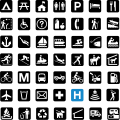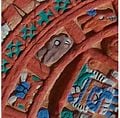Difference between revisions of "Pictogram" - New World Encyclopedia
| Line 5: | Line 5: | ||
| − | + | ||
A '''pictogram''' ([[American and British English spelling differences|also spelled]] ''pictogramme'') or '''pictograph''' is a [[symbol]] representing a [[concept]], [[Object (philosophy)|object]], activity, place or event by [[illustration]]. '''Pictography''' is a form of [[writing]] in which [[idea]]s are transmitted through [[drawing]]. It is a basis of [[Cuneiform (script)|cuneiform]] and, to some extent, [[Egyptian hieroglyphs|hieroglyphic writing]], which uses drawings also as phonetic letters or [[determinative]] rhymes. | A '''pictogram''' ([[American and British English spelling differences|also spelled]] ''pictogramme'') or '''pictograph''' is a [[symbol]] representing a [[concept]], [[Object (philosophy)|object]], activity, place or event by [[illustration]]. '''Pictography''' is a form of [[writing]] in which [[idea]]s are transmitted through [[drawing]]. It is a basis of [[Cuneiform (script)|cuneiform]] and, to some extent, [[Egyptian hieroglyphs|hieroglyphic writing]], which uses drawings also as phonetic letters or [[determinative]] rhymes. | ||
| − | Early written [[symbol]]s were based on pictograms (pictures which resemble what they signify) and [[ideogram]]s (symbols which represent ideas). They were used by the ancient Chinese culture since around 5000 | + | Early written [[symbol]]s were based on pictograms (pictures which resemble what they signify) and [[ideogram]]s (symbols which represent ideas). They were used by the ancient Chinese culture since around 5000 B.C.E. and began to develop into [[logogram|logographic]] [[writing system]]s around 2000 B.C.E. Pictograms are still in use as the main medium of written communication in some non-literate cultures in [[Africa]], [[The Americas]], and [[Oceania]]. Pictograms are often used as simple symbols by most contemporary cultures. |
==Earliest use== | ==Earliest use== | ||
| − | The earliest pictograms were in use in [[Mesopotamia]] and predated the famous [[Sumerian language|Sumerian]] [[Cuneiform script|cuneiforms]] (the oldest of which date to around 3400 | + | The earliest pictograms were in use in [[Mesopotamia]] and predated the famous [[Sumerian language|Sumerian]] [[Cuneiform script|cuneiforms]] (the oldest of which date to around 3400 B.C.E.). As early as 9000 B.C.E. tokens marked with simple pictures began to be used to label basic farm produce. Around 6000 B.C.E., with the rise of cities and spread of basic craftmanship, more complex pictographic tokens were devised to label manufactured goods. Eventually the tokens were replaced by [[clay tablet]]s on which symbols were drawn with a blunt [[Phragmites|reed]] called a [[stylus]]. The impressions left by the stylus were wedge shaped, thus giving rise to the name cuneiform; wedge-writing.<ref>http://pandora.cii.wwu.edu/vajda/ling201/test4materials/Writing2.htm</ref> |
Though written [[Chinese written language|Chinese]] is often thought of consisting of pictograms, less than 4% of all [[Chinese character|characters]] ever created have their direct origins in pictograms. The letters of the [[Roman alphabet]], however, do have their origins in pictograms. For example, the letter ''A'' represented the head of an ox, and if it is turned upside down, a bovine head with horns can be seen. | Though written [[Chinese written language|Chinese]] is often thought of consisting of pictograms, less than 4% of all [[Chinese character|characters]] ever created have their direct origins in pictograms. The letters of the [[Roman alphabet]], however, do have their origins in pictograms. For example, the letter ''A'' represented the head of an ox, and if it is turned upside down, a bovine head with horns can be seen. | ||
| Line 20: | Line 20: | ||
[[Image:Perros No.svg|thumb|150px|"No Dogs!" sign in Spain. The dog illustration is a pictogram. The red circle and bar is an ideogram representing the idea of "no" or "not allowed."]] | [[Image:Perros No.svg|thumb|150px|"No Dogs!" sign in Spain. The dog illustration is a pictogram. The red circle and bar is an ideogram representing the idea of "no" or "not allowed."]] | ||
{{Cleanup|date=April 2008}} | {{Cleanup|date=April 2008}} | ||
| − | Pictograms were extensively used on a London Suburban map of the London & North Eastern Railway map in 1937, and remain in common use today, serving as [[signs]] or [[instructions]]. Because of their graphical nature and fairly realistic style, they are widely used to indicate public [[toilet]]s, or places such as [[airport]]s and [[train station]]s. However, even these symbols are highly culture-specific. For example, in some cultures men commonly wear dress-like clothing, so even restroom signage is not universal. | + | Pictograms were extensively used on a London Suburban map of the London & North Eastern Railway map in 1937, and remain in common use today, serving as [[signs]] or [[instructions]]. Because of their graphical nature and fairly realistic style, they are widely used to indicate public [[toilet]]s, or places such as [[airport]]s and [[train station]]s. However, even these symbols are highly culture-specific. For example, in some cultures men commonly wear dress-like clothing, so even restroom signage is not universal. |
A standard set of pictograms was defined in the [[international standard]] ''[[International Organization for Standardization|ISO]] [[ISO 7001|7001]]: Public Information Symbols''. Another common set of pictograms are the [[laundry symbols]] used on clothing tags and [[chemical hazard label]]s. Pictography hinders [[search engine|search-engine]] capability, requiring symbol searching, while text-based writing also facilitates spoken words, even new words by use of pronunciation rules, and text enables sorting information alphabetically. | A standard set of pictograms was defined in the [[international standard]] ''[[International Organization for Standardization|ISO]] [[ISO 7001|7001]]: Public Information Symbols''. Another common set of pictograms are the [[laundry symbols]] used on clothing tags and [[chemical hazard label]]s. Pictography hinders [[search engine|search-engine]] capability, requiring symbol searching, while text-based writing also facilitates spoken words, even new words by use of pronunciation rules, and text enables sorting information alphabetically. | ||
| Line 27: | Line 27: | ||
Pictograms can also be seen in various [[crop circles]]. | Pictograms can also be seen in various [[crop circles]]. | ||
| + | ===DOT pictograms=== | ||
| + | The '''DOT pictograms''' are a set of fifty [[pictogram]]s used to convey information useful to travelers without using words. Such images are useful in airports, train stations, hotels, and other public places for foreign tourists, as well as being easier to identify than strings of text. Among these pictograms are the now-familiar graphics representing [[toilet]]s and [[telephone]]s. As a result of this near-universal acceptance, some describe them as the "[[Helvetica]]" of pictograms, and the character portrayed within them as '''Helvetica Man''' (Lupton). | ||
| + | |||
| + | As works of the United States government, the images are in the [[public domain]] and thus can be used by anyone for any purpose, without licensing issues. | ||
| + | |||
| + | [[Image:DOT pictograms.svg|thumb|center|450px|DOT pictograms representing, from left, "Escalator (up)," "Nursery" and "Ground transportation".]] | ||
| + | |||
| + | |||
| + | In 1974, the [[United States Department of Transportation]] (DOT) recognized the shortcomings of pictograms drawn on an [[ad hoc]] basis across the United States [[Interstate Highway System]] and commissioned the [[American Institute of Graphic Arts]] to produce a comprehensive set of pictograms. In collaboration with [[Roger Cook (graphic designer)|Roger Cook]] and [[Don Shanosky]] of [[Cook and Shanosky Associates]], the designers conducted an exhaustive survey of pictograms already in use around the world, which drew from sources as diverse as [[Tokyo International Airport]] and the 1972 [[Olympic Games]] in [[Munich]]. The designers rated these pictograms based on criteria such as their legibility, their international recognizability and their resistance to vandalism. After determining which features were the most successful and appropriate, the designers drew a set of pictograms to represent 34 meanings requested by the DOT. | ||
| + | |||
| + | In 1979, 16 symbols were added, bringing the total to 50. | ||
| + | |||
| + | ===ISO 7001=== | ||
| + | [[Image:Parking icon.svg|thumb|The symbol used ubiquitously in the United States to represent parking areas.]] | ||
| + | '''ISO 7001''' ("Public information symbols") is a standard published by the [[International Organization for Standardization]] that defines a set of pictograms and symbols for public information. The latest version, ISO 7001:2007, has been published in November 2007. | ||
| + | |||
| + | The set is the result of extensive testing in several countries and different cultures and have met the criteria for comprehensibility set up by the ISO. Common examples of public information symbols include those representing toilets, car parking, and information, and the [[International Symbol of Access]]. | ||
| + | |||
| + | |||
<gallery> | <gallery> | ||
| Line 38: | Line 57: | ||
== See also == | == See also == | ||
| − | + | ||
*[[Chinese character]] | *[[Chinese character]] | ||
*[[DOT pictograms]] | *[[DOT pictograms]] | ||
| Line 48: | Line 67: | ||
*[[Asemic]] Writing | *[[Asemic]] Writing | ||
| − | == References == | + | ==References== |
| − | * | + | * Ellen Lupton and J. Abbott Miller. ''Design Writing Research: Writing About Graphic Design.'' New York: Kiosk, 1996. |
| + | * The Professional Association for Design for the U.S. Department of Transportation. ''Symbol signs,'' 2nd ed. New York: American Institute of Graphic Arts, 1993. | ||
| + | |||
| + | |||
| + | * Reed, Ishmael (2003). ''From Totems to Hip-Hop: A Multicultural Anthology of Poetry Across the Americas, 1900-2002'', Ishmael Reed, ed. ISBN 1-56025-458-0. | ||
==External links== | ==External links== | ||
*[http://www.washjeff.edu/capl/ CAPL:The Culturally Authentic Pictorial Lexicon, photographic illustrations of objects for English-German] | *[http://www.washjeff.edu/capl/ CAPL:The Culturally Authentic Pictorial Lexicon, photographic illustrations of objects for English-German] | ||
| − | {{Credits|Pictogram|215215012|}} | + | |
| + | * [http://www.aiga.org/content.cfm/symbol-signs DOT pictograms (symbol signs)] | ||
| + | * [http://funwithstuff.com/dswmedia/airport.html Airport], an animated film made from AIGA pictograms | ||
| + | * [http://www.iso.org/iso/iso_catalogue/catalogue_tc/catalogue_detail.htm?csnumber=41081 Purchase the ISO 7001:2007 standard] | ||
| + | |||
| + | |||
| + | |||
| + | {{Credits|Pictogram|215215012|DOT_pictograms|155177407|ISO_7001|171320115}} | ||
Revision as of 00:00, 27 June 2008
A pictogram (also spelled pictogramme) or pictograph is a symbol representing a concept, object, activity, place or event by illustration. Pictography is a form of writing in which ideas are transmitted through drawing. It is a basis of cuneiform and, to some extent, hieroglyphic writing, which uses drawings also as phonetic letters or determinative rhymes.
Early written symbols were based on pictograms (pictures which resemble what they signify) and ideograms (symbols which represent ideas). They were used by the ancient Chinese culture since around 5000 B.C.E. and began to develop into logographic writing systems around 2000 B.C.E. Pictograms are still in use as the main medium of written communication in some non-literate cultures in Africa, The Americas, and Oceania. Pictograms are often used as simple symbols by most contemporary cultures.
Earliest use
The earliest pictograms were in use in Mesopotamia and predated the famous Sumerian cuneiforms (the oldest of which date to around 3400 B.C.E.). As early as 9000 B.C.E. tokens marked with simple pictures began to be used to label basic farm produce. Around 6000 B.C.E., with the rise of cities and spread of basic craftmanship, more complex pictographic tokens were devised to label manufactured goods. Eventually the tokens were replaced by clay tablets on which symbols were drawn with a blunt reed called a stylus. The impressions left by the stylus were wedge shaped, thus giving rise to the name cuneiform; wedge-writing.[1]
Though written Chinese is often thought of consisting of pictograms, less than 4% of all characters ever created have their direct origins in pictograms. The letters of the Roman alphabet, however, do have their origins in pictograms. For example, the letter A represented the head of an ox, and if it is turned upside down, a bovine head with horns can be seen.
Modern use
Template:Cleanup Pictograms were extensively used on a London Suburban map of the London & North Eastern Railway map in 1937, and remain in common use today, serving as signs or instructions. Because of their graphical nature and fairly realistic style, they are widely used to indicate public toilets, or places such as airports and train stations. However, even these symbols are highly culture-specific. For example, in some cultures men commonly wear dress-like clothing, so even restroom signage is not universal.
A standard set of pictograms was defined in the international standard ISO 7001: Public Information Symbols. Another common set of pictograms are the laundry symbols used on clothing tags and chemical hazard labels. Pictography hinders search-engine capability, requiring symbol searching, while text-based writing also facilitates spoken words, even new words by use of pronunciation rules, and text enables sorting information alphabetically.
Pictographic writing as a modernist poetic technique is credited to Ezra Pound though French surrealists accurately credit the Pacific Northwest American Indians of Alaska who introduced writing, via totem poles, to North America (Reed 2003, p. xix).
Pictograms can also be seen in various crop circles.
DOT pictograms
The DOT pictograms are a set of fifty pictograms used to convey information useful to travelers without using words. Such images are useful in airports, train stations, hotels, and other public places for foreign tourists, as well as being easier to identify than strings of text. Among these pictograms are the now-familiar graphics representing toilets and telephones. As a result of this near-universal acceptance, some describe them as the "Helvetica" of pictograms, and the character portrayed within them as Helvetica Man (Lupton).
As works of the United States government, the images are in the public domain and thus can be used by anyone for any purpose, without licensing issues.
In 1974, the United States Department of Transportation (DOT) recognized the shortcomings of pictograms drawn on an ad hoc basis across the United States Interstate Highway System and commissioned the American Institute of Graphic Arts to produce a comprehensive set of pictograms. In collaboration with Roger Cook and Don Shanosky of Cook and Shanosky Associates, the designers conducted an exhaustive survey of pictograms already in use around the world, which drew from sources as diverse as Tokyo International Airport and the 1972 Olympic Games in Munich. The designers rated these pictograms based on criteria such as their legibility, their international recognizability and their resistance to vandalism. After determining which features were the most successful and appropriate, the designers drew a set of pictograms to represent 34 meanings requested by the DOT.
In 1979, 16 symbols were added, bringing the total to 50.
ISO 7001
ISO 7001 ("Public information symbols") is a standard published by the International Organization for Standardization that defines a set of pictograms and symbols for public information. The latest version, ISO 7001:2007, has been published in November 2007.
The set is the result of extensive testing in several countries and different cultures and have met the criteria for comprehensibility set up by the ISO. Common examples of public information symbols include those representing toilets, car parking, and information, and the International Symbol of Access.
Sample National Park Service pictographs
Pictograph from 1510 telling a story of coming of missionaries to Hispaniola
Water, rabbit, deer pictograms on a replica of an Aztec Stone of the Sun
See also
- Chinese character
- DOT pictograms
- Emoticon
- Icon (computing)
- Ideogram
- Writing system
- Yakima Indian Painted Rocks
- Asemic Writing
ReferencesISBN links support NWE through referral fees
- Ellen Lupton and J. Abbott Miller. Design Writing Research: Writing About Graphic Design. New York: Kiosk, 1996.
- The Professional Association for Design for the U.S. Department of Transportation. Symbol signs, 2nd ed. New York: American Institute of Graphic Arts, 1993.
- Reed, Ishmael (2003). From Totems to Hip-Hop: A Multicultural Anthology of Poetry Across the Americas, 1900-2002, Ishmael Reed, ed. ISBN 1-56025-458-0.
External links
- DOT pictograms (symbol signs)
- Airport, an animated film made from AIGA pictograms
- Purchase the ISO 7001:2007 standard
Credits
New World Encyclopedia writers and editors rewrote and completed the Wikipedia article in accordance with New World Encyclopedia standards. This article abides by terms of the Creative Commons CC-by-sa 3.0 License (CC-by-sa), which may be used and disseminated with proper attribution. Credit is due under the terms of this license that can reference both the New World Encyclopedia contributors and the selfless volunteer contributors of the Wikimedia Foundation. To cite this article click here for a list of acceptable citing formats.The history of earlier contributions by wikipedians is accessible to researchers here:
The history of this article since it was imported to New World Encyclopedia:
Note: Some restrictions may apply to use of individual images which are separately licensed.







